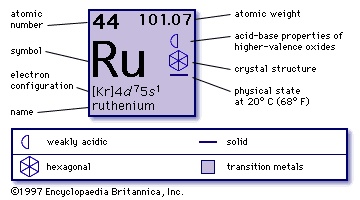ruthenium
chemical element
 chemical element, one of the platinum metals (platinum group) of Groups 8–10 (VIIIb), Periods 5 and 6, of the periodic table, used as an alloying agent to harden platinum and palladium. Silver-gray ruthenium metal looks like platinum but is rarer, harder, and more brittle. The Russian chemist Karl Karlovich Klaus (Klaus, Karl Karlovich) established (1844) the existence of this rare, bright metal and retained the name his countryman Gottfried Wilhelm Osann had suggested (1828) for a platinum-group element whose discovery had remained inconclusive. Ruthenium has a low crustal abundance of about 0.001 part per million. Elemental ruthenium occurs in native alloys of iridium and osmium, along with the other platinum metals: up to 14.1 percent in iridosmine and 18.3 percent in siserskite. It also occurs in sulfide and other ores (e.g., in pentlandite of the Sudbury, Ont., Can., nickel-mining region) in very small quantities that are commercially recovered.
chemical element, one of the platinum metals (platinum group) of Groups 8–10 (VIIIb), Periods 5 and 6, of the periodic table, used as an alloying agent to harden platinum and palladium. Silver-gray ruthenium metal looks like platinum but is rarer, harder, and more brittle. The Russian chemist Karl Karlovich Klaus (Klaus, Karl Karlovich) established (1844) the existence of this rare, bright metal and retained the name his countryman Gottfried Wilhelm Osann had suggested (1828) for a platinum-group element whose discovery had remained inconclusive. Ruthenium has a low crustal abundance of about 0.001 part per million. Elemental ruthenium occurs in native alloys of iridium and osmium, along with the other platinum metals: up to 14.1 percent in iridosmine and 18.3 percent in siserskite. It also occurs in sulfide and other ores (e.g., in pentlandite of the Sudbury, Ont., Can., nickel-mining region) in very small quantities that are commercially recovered.Because of its high melting point, ruthenium is not easily cast; its brittleness, even at white heat, makes it very difficult to roll or draw into wires. Thus, the industrial application of metallic ruthenium is restricted to use as an alloy for platinum and other metals of the platinum group. Processes for isolating it are an integral part of the metallurgical art that applies to all platinum metals. It serves the same function as iridium for the hardening of platinum and, in conjunction with rhodium, is used to harden palladium. Ruthenium-hardened alloys of platinum and palladium are superior to the pure metals in the manufacture of fine jewelry and of electrical contacts for wear resistance.
Ruthenium is found among the fission products of uranium and plutonium in nuclear reactors. Radioactive ruthenium-106 (one-year half-life) and its short-lived daughter rhodium-106 contribute an important fraction of the residual radiation in reactor fuels a year following their use. Recovery of the unused fissionable material is made difficult because of the radiation hazard and the chemical similarity between ruthenium and plutonium.
Natural ruthenium consists of a mixture of seven stable isotopes: ruthenium-96 (5.54 percent), ruthenium-98 (1.86 percent), ruthenium-99 (12.7 percent), ruthenium-100 (12.6 percent), ruthenium-101 (17.1 percent), ruthenium-102 (31.6 percent), and ruthenium-104 (18.6 percent). It has four allotropic forms. Ruthenium has a high resistance to chemical attack. Ruthenium is, with osmium, the most noble of the platinum metals; the metal does not tarnish in air at ordinary temperatures and resists attack by strong acids, even by aqua regia. Ruthenium is brought into soluble form by fusion with an alkaline oxidizing flux, such as sodium peroxide (Na2O2), especially if an oxidizing agent such as sodium chlorate is present. The green melt contains the perruthenate ion, RuO-41PT; on dissolving in water, an orange solution containing the stable ruthenate ion, RuO42-, usually results.
The −2 and 0 through +8 states are known, but +2, +3, +4, +6, and +8 are most important. In addition to carbonyl and organometallic compounds in the low oxidation states −2, 0, and +1, ruthenium forms compounds in every oxidation state from +2 to +8. Very volatile ruthenium tetroxide, RuO4, used in separating ruthenium from other heavy metals, contains the element in the +8 oxidation state. (Although ruthenium tetroxide, RuO4, has similar stability and volatility to osmium tetroxide, OsO4, it differs in that it cannot be formed from the elements.) The chemistries of ruthenium and osmium are generally similar. The higher oxidation states +6 and +8 are much more readily obtained than for iron, and there is an extensive chemistry of the tetroxides, oxohalides, and oxo anions. There is little, if any, evidence that simple aquo ions exist, and virtually all its aqueous solutions, whatever the anions present, may be considered to contain complexes. Numerous coordination complexes are known, including a unique series of nitrosyl (NO) complexes.
atomic number
44
atomic weight
101.07
melting point
2,250° C (4,082° F)
boiling point
3,900° C (7,052° F)
specific gravity
12.30 (20° C)
valence
1, 2, 3, 4, 5, 6, 7, 8
electronic config.
2-8-18-15-1 or (Kr)4d75s1
- Laveran, Alphonse
- LaVern Baker
- Laver, Rod
- La Victoria
- Lavigerie, Charles
- Lavinia Fenton
- Lavinia Fontana
- Lavinium
- Lavoisier, Antoine-Laurent
- la volta
- Lavon, Pinhas
- Lavrenty Pavlovich Beria
- Lavr Georgiyevich Kornilov
- Lavrov, Pyotr
- La Vérendrye, Pierre Gaultier de Varennes, et de
- law
- Lawamon
- Law, Bonar
- law code
- Lawes, Henry
- Lawes, Lewis Edward
- Lawes, Sir John Bennet, 1st Baronet
- Lawes, William
- Law, John
- Lawler, Ray